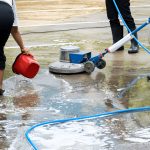Toilet waterproofing failures have silently devastated thousands of Singapore homes, causing billions in damage annually, yet most residents remain unaware of the risk until water begins seeping through their expensive marble tiles. In a high-rise condominium overlooking Marina Bay, Mr. Tan discovered this harsh reality when brownish water began pooling mysteriously in his master bathroom corner—the first visible sign that his recent $85,000 renovation had catastrophically failed beneath the pristine surface.
The Perfect Storm: Singapore’s Unique Vulnerability
The tropical climate that bathes Singapore in warmth and humidity creates ideal conditions for waterproofing failures. Unlike temperate climates where bathrooms might remain dry for days, Singapore’s particular challenges include:
- Year-round humidity consistently above 80%, preventing surfaces from fully drying
- Average annual rainfall exceeding 2,300mm, creating constant moisture pressure
- Daily shower usage rates 40% higher than global averages due to climate
- High-rise construction that creates significant water pressure differentials between floors
- Urban heat island effect that accelerates material degradation
“Singapore represents perhaps the most challenging environment for bathroom waterproofing globally,” explains a veteran building inspector with thirty years of experience across Southeast Asia. “The combination of climate factors, high-density living, and luxury finishing materials creates perfect conditions for catastrophic failures that often remain hidden until extensive damage has occurred.”
The Anatomy of Disaster: How Water Infiltrates
The destruction begins silently beneath the surface, in the critical interface between the waterproofing toilet floor membrane and the structural concrete slab. Water finding even microscopic pathways through compromised waterproofing initiates a cascade of deterioration:
- Moisture penetrates through grout lines and microscopic tile pores
- Water accumulates between the waterproofing membrane and tiled surface
- Constant moisture creates ideal conditions for bacterial and fungal growth
- Expansion and contraction cycles gradually enlarge initial penetration points
- Water eventually reaches electrical conduits, creating potential safety hazards
“When I removed the first tiles from Mr. Tan’s bathroom floor, the concrete screed beneath had the consistency of wet cardboard,” recounts a remediation specialist who has addressed over 300 bathroom waterproofing failures. “His waterproofing membrane had detached completely from the substrate, creating a hidden reservoir of stagnant water just millimetres beneath his feet.”
The Warning Signs: Recognising Imminent Failure
Most waterproofing failures announce themselves through subtle indicators long before catastrophic damage occurs. Vigilant homeowners should watch for:
- Persistent musty odours that intensify during humid weather
- Efflorescence—white crystalline deposits appearing on bathroom walls
- Gradually darkening grout lines, particularly in shower corners
- Unexplained moisture appearing on ceilings of units below
- Tiled surfaces that feel unusually cold or retain moisture hours after use
- Mould formation at wall-floor junctions despite regular cleaning
“By the time visible water appears, you’re typically looking at a comprehensive remediation project rather than a simple repair,” warns a consultant who specialises in forensic investigation of building failures. “The visible portion represents perhaps 20% of the actual damage.”
The Science Behind Effective Waterproofing
Proper waterproofing toilet floor systems involve multiple redundant layers that work together:
- Substrate preparation including removal of all dust, oil and contaminants
- Application of penetrative sealants that bond molecularly with concrete
- Flexible membrane systems that accommodate thermal movement
- Protective screed layers that shield membranes from damage during tiling
- Properly specified tile adhesives compatible with underlying systems
- Water-resistant grouting with appropriate elasticity
“The fundamental mistake I witness repeatedly involves treating waterproofing as a simple product application rather than an integrated system,” observes a materials scientist who has studied waterproofing failures across Singapore for over two decades. “Each component must function in concert with adjacent materials under constantly changing conditions.”
The Human Factor: Where Most Failures Begin
Behind nearly every waterproofing failure lies a human decision that compromised the system’s integrity. Common critical errors include:
- Inadequate surface preparation before membrane application
- Insufficient drying time between waterproofing layers
- Membrane perforation during subsequent construction
- Incompatible materials creating chemical degradation
- Cost-cutting substitutions of critical components
- Skipping mandatory flood tests before tiling
“I’ve documented cases where contractors punctured newly applied waterproofing membranes over 200 times while installing shower fixtures and toilet mounting bolts,” reports a building inspector who specialises in quality assurance for luxury developments. “Each penetration becomes a potential water pathway, virtually guaranteeing future failure.”
Beyond Remediation: The Prevention Paradigm
For homeowners navigating renovation projects, preventing waterproofing failures requires diligence beyond typical contractor oversight:
- Insist on detailed waterproofing specifications before work begins
- Document application of each waterproofing component with date-stamped photographs
- Require mandatory flood testing with independent verification
- Allow full manufacturer-specified curing times between stages
- Maintain detailed records of all products and application methods used
- Schedule periodic professional inspections to detect early failure indicators
Conclusion
The hidden crisis of bathroom waterproofing failures continues affecting thousands of Singapore homes annually, with average remediation costs exceeding $30,000 per incident. Beyond financial implications, these failures create health hazards through mould proliferation and potential structural compromises that threaten entire buildings. As Singapore’s construction boom continues and more homeowners undertake bathroom renovations, understanding these critical systems becomes essential for protecting both property value and family health. The difference between decades of trouble-free performance and catastrophic failure often comes down to decisions made during those critical days of installation, when contractors either respect or compromise the complex science of bathroom waterproofing.










